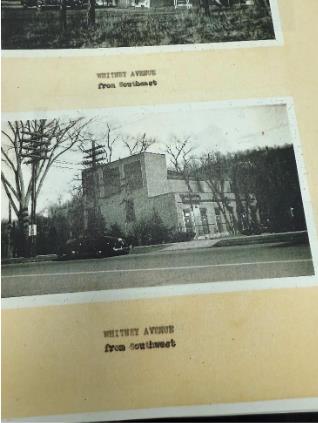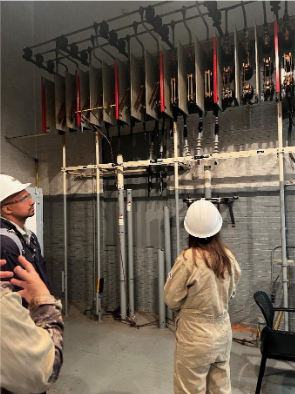UI Phases Out Last Early-1900s Substation as Part of Transition to More Resilient, Modern Electric System
By deenergizing Whitney Avenue Substation, UI is delivering on its reliability commitments to greater New Haven.
WATCH: UI on the Whitney Avenue Substation Decommissioning


At left: Whitney Avenue Substation in December 1941. At right: UI workers survey 1950s-era infrastructure in Whitney Avenue Substation.
ORANGE, Conn. — July 1, 2025 — Today, United Illuminating (UI), a subsidiary of Avangrid, Inc., announced that it has deenergized and decommissioned Whitney Avenue Substation, the company’s oldest substation that served approximately 10,000 customers in northern New Haven/southern Hamden. With the deenergization of Whitney Avenue Substation, which was the last 4-kilovolt (kV) substation in UI’s service area, all 345,000 customers in UI’s service area are now served by more modern and efficient 13.8-kV substations, which promotes reliability for customers while protecting workers from the potential safety hazards of operating century-old electric infrastructure.
“Whitney Avenue Substation is a relic of history, one that has served New Haven and Hamden customers with safe, reliable electricity since before World War I,” said Frank Reynolds, President and CEO of UI. “While we’re proud that our infrastructure is so strong and well-built that it can serve our customers for more than a century, it’s time for us to invest in significant improvements for our customers located in New Haven and Hamden by transitioning these circuits to more modern, efficient electric infrastructure. Safety, reliability, and resiliency are our core values, and decommissioning Whitney Avenue Substation demonstrates the strength of our commitment to these tenets.”
Built around 1915, the Whitney Avenue Substation underwent several upgrade and modernization projects throughout its history before it was fully deenergized on Tuesday, June 10. Early on, the substation distributed electricity at 2.3 kV using oil-filled circuit breakers located inside the building. It underwent its most significant modernization and expansion project in the 1950s, when these oil-filled circuit breakers were removed and replaced with then-state-of-the-art non-oil-based circuit breakers, which allowed the substation to begin distributing at 4 kV.
In the 1970s, UI asked for support from state regulators to begin transforming all its customers’ circuits from 2.4 kV and/or 4 kV substations to 13.8-kV substations. Technological advancements meant that UI could distribute electricity into its distribution system at 13.8 kV, whereas previously, the electricity needed to be further reduced prior to distribution. Thus, by upgrading its distribution network to support distribution at 13.8 kV, UI could render 4-kV substations obsolete, which would ultimately reduce the number of substations needed across the company’s service area and increase efficiency, reliability, and employee safety.
“As a 36-year member of UI’s Electric Operations team, seeing Whitney Avenue Substation come off-line is a powerful moment for me,” said Chuck Eves, Vice President of Electric Operations at UI. “By decommissioning our last 4-kV substation, we’ve made a powerful statement about the depth of our commitment to reliability for our customers and the safety of our front-line workers. We kept our 4-kV substations, including Whitney Avenue, in service for as long as possible to ensure our customers aren’t paying for infrastructure upgrades they don’t need. Now, every single one of our customers – in New Haven, Hamden, and across our service area – is benefitting from our investments in modern, efficient electricity service, enjoying greater reliability and resiliency that will last decades to come.”
Until the late 2010s, UI received support from state regulators to systematically make the infrastructure upgrades to deenergize 4-kV substations and reroute all distribution circuits to 13.8-kV substations. These investments have resulted in the number of substations in UI’s service area falling from more than 100 at its peak to around 30 today. The upgrades also ensure that UI front-line workers are not exposed to the potential safety hazards of operating extremely aged infrastructure, and that customers receive best-in-class reliability, as extremely aged substations are more likely to fail and lead to outages.
In its 2022 rate case (Docket #22-08-08), UI asked state regulators at the Public Utilities Regulatory Authority (PURA) to provide support for deenergizing Whitney Avenue Substation, the company’s last 4-kV substation. However, PURA determined that UI had not provided sufficient evidence that decommissioning the nearly 110-year-old substation was a prudent decision that benefitted customers, and denied funding for it.1
Despite UI’s lack of funding to decommission Whitney Avenue Substation and reroute all its circuits to newer 13.8-kV substations, UI Vice President of Electric Operations Chuck Eves determined that its continued operation would eventually pose safety and reliability risks to the company’s front-line workers and customers. Thus, while the project resulted in further degradation of UI’s financial metrics, UI’s leadership prioritized safety and reliability and completed the deenergization in mid-June.
